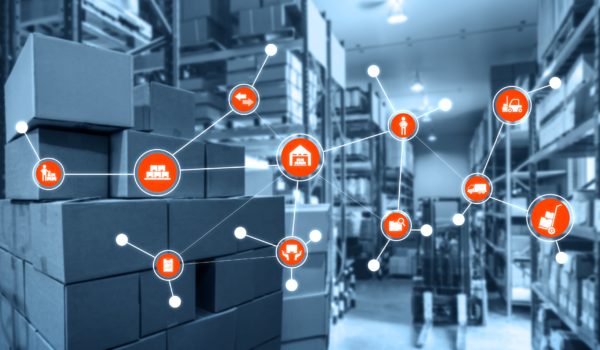Supply chain management (SCM) is one of the primary methods for optimizing the budgets of businesses that produce goods and services. It is a sector of industry where innovations and digital disruption can drastically change the way people do business. On the other hand, transformation is highly complex and requires specialized knowledge.
At the same time, logistics – the management of physical, informational, and human flows to optimize them and avoid wasteful waste of resources plays a significant role in supply chains.
We will discuss the crucial function of logistics management in supply chain management, which involves many suppliers, transit locations, and points of departure and destination. A better understanding of SCM can illuminate how to automate routine activities and what goals should be set before designing appropriate software.
What Is the Distinction Between Logistics and Supply Chains?
The terms logistics and supply chain should not be used interchangeably. Logistics is an instead narrowly defined notion (narrower than SCM) that refers to the globalization of resource management — from every local unit to the complete network of production points.
On the other hand, supply chain management is a more complex category. Supply chain management incorporates logistics and accomplishes end-to-end optimization, not only within the organization but also while collaborating with counterparties.
Effective logistics management aims to maximize the company’s competitiveness and profitability, as well as the complete network structure of supply chains, including the end-user. In this regard, the integration and introduction of innovations into the supply chain and logistics activities should strive to increase the total productivity of all participants.
Let’s look more closely at the distinctions between logistics and supply chain management:
Logistics as a Component of Supply Chain Management
The most important distinction that will help you understand the concept of logistics and supply chain management is that logistics is a subset of supply chain management. Production and inventory planning, materials management, manufacturing, and delivery are all part of supply chain management. At the same time, logistics is only concerned with the timely and efficient delivery and transportation of goods, encompassing responsibilities such as stock management, warehousing, and packing.
Different Goals
Logistics is a component of supply chain management concerned with meeting customer expectations and delivering products and services in the most efficient and accessible manner possible.
The supply chain considers the big picture and attempts to improve business operations to gain a competitive advantage.
Complexity
Understanding logistics as a component of supply chain management allows us to recognize the distinction in complexity between the two concepts. Logistics has been established for centuries and is concerned with transportation management in the supply chain. Supply chain management emerged when the complexity of corporate operations and relationships got too great in the modern world. Companies nowadays engage with suppliers, intermediaries, distributors, and customers. Therefore the supply chain has become an essential component of modern business.

Logistics Functions in Supply Chain Management
We can identify the following functions by systematizing all areas of logistics that need to be created for the rational management of production resources:
- Design and management of warehouses
This role of logistics in supply chain management encompasses numerous duties at once, beginning with the design of storage facilities and finishing with the implementation of various automation solutions (for example, machinery intended for carrying goods within warehouses).
- Package construction
Packaging, tracking, and accounting are duties that enable complete control of goods on their path to the customer/distributor.
- Product transportation
This includes working with cargo carriers and cars in the company’s fleet to arrange their routes, calculate fuel expenses, and so on.
- Taking care of customs
When an organization prepares overseas delivery of goods, it is critical that the commodities fully comply with customs standards and carry all relevant documentation during shipping.
- Working with intermediaries
Intermediaries in logistics are any third-party, non-company resources directly involved in supply chain implementation. Finding intermediaries with the most acceptable quality-to-cost ratio of services and creating long-term, dependable relationships with them are also on the list of requirements for an efficient logistics management function.
- Working with returned and written-off products
There is also “reverse logistics,” which specifies the norms and routes for carrying returned/discarded products, as well as methods of disposal.
Proper Logistics Significantly Improves Supply Chain Management
Given the following list of logistical duties in supply chain management, we can identify many benefits offered by proper implementation:
- Cost-cutting measures for the business
In supply chain management, the primary objective of logistics is to increase the overall value of each delivery, as measured by customer satisfaction. This means that labor resource reduction and optimization must be linked to maintaining a particular degree of quality customer service. This issue is addressed by both decreasing overall labor resources (mainly by eliminating superfluous chain links) and implementing automated solutions.
- Consolidation of traffic volumes
Transportation expenditures are one of the most significant expenses in logistics management, and they often rise in proportion to the distance traveled, batch size and product exposure to damage. However, the transportation cost per unit of weight falls as lot size increases in the long run. As a result, maximizing transportation volume consolidation can assist in lowering transportation expenses. Enlargement can be accomplished by combining tiny lots into a single large one designed for a long run (i.e., a greater distance).
- Improving the level of service
Concerning service quality, it is primarily influenced by the speed with which goods are delivered to the end-user, as well as their transportation in proper conditions (for example, many products today are supplied with RFID tags, allowing both the manufacturer and the end customer to track whether all storage conditions are being observed during the transportation of the goods) and within the allowed time limits (this applies primarily to perishable goods);
- Actual losses are reduced, as are potential hazards
As you are aware, a business is profitable if the value it provides surpasses the costs related to activity implementation. To gain a competitive advantage, a company must either perform these tasks at a cheaper cost or perform them in a way that leads to distinctiveness and price increases. The first step toward adequately resolving this issue is to limit the losses associated with product returns.
It is critical to plan the routes to the distributor or end-user and the routes by which the goods are returned to the warehouse or enterprises for disposal. The second aspect influencing risk reduction is proper enterprise resource planning, which reduces the chance of damage or loss of goods or manufacturing components on the path from raw material extraction through the delivery of the final product/service to the end-user.
- Reduced reliance on intermediary services
The majority of the expense of implementing supply chains is borne by intermediary services. Experienced logisticians create routes to reduce the requirement for third-party services to achieve efficient logistics management.
The required documents must accompany goods. Insurance and documentation assistance are two key logistics activities, the resolution of which helps to eliminate any complications related to legal constraints in the storage, transit, and sale of goods.
- Response to changing market demands in a timely manner
Advanced logistics scenarios also assist in fast adapting to changing market requirements and, as a result, maintaining top positions against competitors and remaining in demand for the target audience.
Logistics Provides Value to the Supply Chain Business
Using logistics technologies, supply chain management helps provide a consistently high quality of customer service while lowering the cost of extracting raw materials, storing, delivering, and selling goods/services to end-users. As a result, the role of logistics in supply chain management carries the following values:
- Ensuring that all components of the supply chain run smoothly
Continuity of workflow is a quick step toward cost reduction and increased customer satisfaction. Typically, this is accomplished by careful planning and the development of a fault-tolerant structure of interaction among the individual links in the supply chain.
- Release of labor resources
On the other hand, fault tolerance necessitates the deletion of superfluous elements, the involvement in which incurs additional expenses. As a result, it is critical to strike a balance in which the reduction in labor resources does not result in forced downtime during supply chain deployment.
- Сoverage of a new target demographic
Increasing total client happiness is a quick way to popularize your business through word of mouth. Another benefit is that such advertising is entirely free for you.
- Net cost savings
By removing several intermediary connections in the supply chain, you can lower the net cost of a product or service and increase its availability to the end consumer.
Final Thoughts
Let us summarize logistics’ role in supply chain management. As you can see, supply chain management and logistics are two intertwined ideas that help reduce the company’s overall expenses for producing goods and services while also improving your target audience’s overall image of the level of service. The selection of the appropriate software is also essential in optimizing logistical duties. After all, automation is now at the forefront of industrial enterprise progress.
Please contact Iskedez Solutions if you are interested in designing a customized solution for your business, particularly for streamlining supply chains and overcoming logistics difficulties. We will develop cost-effective, scalable, and dependable products that you may tailor to your company’s exact requirements.
Iskedez Solutions is a supply chain software development firm that provides high-quality solutions with unique features suited to specific demands and needs.
